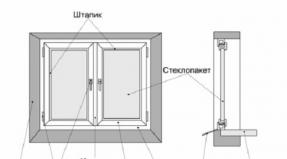Vibrocil - nasal drops for children and adults, application features. Vibrocil for children: instructions for use and what it is for, nose drops for a cold, reviews, price Vibrocil instructions for use
Vibrocil- a drug with a vasoconstrictor and antiallergic effect for local use in diseases of the ENT organs.
Phenylephrine is a sympathomimetic, with topical application has a moderate vasoconstrictor effect (due to the stimulation of α1-adrenergic receptors of the venous vessels of the nasal mucosa), eliminates edema of the nasal mucosa and paranasal sinuses.
Dimetindene is a histamine H1 receptor blocker. Provides antiallergic effect. Does not reduce the activity of the ciliated epithelium of the nasal mucosa.
Pharmacokinetics
Vibrocil intended for topical use, and its activity does not depend on the concentration of active substances in the blood plasma.
Mode of application
Before using the drug, you should thoroughly clean the nasal cavity.Vibrocil nasal drops instilled into each nasal passage 3-4 times / day. For children under 1 year old single dose- 1 drop. For children aged 1 to 6 years, a single dose is 1-2 drops. For children over the age of 6 and adults, a single dose is 3-4 drops. Before using the drug, you should thoroughly clean the nasal cavity. Nasal drops are instilled into the nose with the head thrown back. This head position is maintained for several minutes. Infants are buried in the nose before feeding.
Nasal spray Vibrocil children over the age of 6 and adults are prescribed 1-2 injections into each nasal passage 3-4 times / day. The spray should be held vertically, tip up. Keeping the head straight, insert the tip into the nostril, squeeze the nebulizer once with a short sharp movement and, removing the tip from the nose, unclench it. During the injection, it is recommended to inhale slightly through the nose.
Nasal gel Vibrocil children over the age of 6 and adults are injected into each nasal passage as deep as possible 3-4 times / day. The use of a nasal gel immediately before bedtime ensures that there is no nasal congestion throughout the night.
Overdose
Symptoms In case of accidental reception Vibrocil inside by young children, no serious side effects.In most cases, there were no symptoms of an overdose, however, sometimes symptoms such as fatigue, pain in the stomach, tachycardia, arterial hypertension, agitation, insomnia, pallor of the skin (more often in children with accidental ingestion).
Treatment: the use of activated charcoal and possibly a laxative (gastric lavage is not required); adults and children over the age of 6 are shown the introduction of a large amount of fluid. There is no specific antidote.
Drug interactions
Phenylephrine (like other vasoconstrictor drugs) is contraindicated in patients receiving MAO inhibitors at this time or having received them within the previous two weeks.
You should not prescribe the drug simultaneously with tricyclic antidepressants or antihypertensive drugs, for example, beta-blockers.
Pregnancy and lactation
Given the possible systemic vasoconstrictor effect, Vibrocil not recommended for use during pregnancy and lactation.
Side effects
Local reactions: rarely - a mild and transient burning sensation and dryness of the nasal mucosa.Storage conditions and periods
The drug in the form of nasal drops and nasal spray should be stored in a dark place out of the reach of children at a temperature not exceeding 30 ° C, the drug in the form of a nasal gel should be stored out of the reach of children at a temperature not higher than 30 ° C. Shelf life is 3 years.
Indications
— acute rhinitis(including at colds);
— allergic rhinitis(including at hay fever);
— vasomotor rhinitis;
- chronic rhinitis;
- acute and chronic sinusitis;
- Acute otitis media (as an adjuvant);
- preparation for surgical interventions in the nasal area and elimination of edema of the nasal mucosa and paranasal sinuses after surgery in this area.
Contraindications
- atrophic rhinitis (including with fetid discharge - ozena);- simultaneous administration of MAO inhibitors and a period up to 14 days after their cancellation;
— childhood up to 6 years (for nasal spray);
- hypersensitivity to the components of the drug.
The drug should be used with caution when cardiovascular diseases(arterial hypertension, arrhythmias, generalized atherosclerosis), diseases thyroid gland, angle-closure glaucoma, benign hyperplasia prostate, insulin-dependent diabetes mellitus.
Caution should be given to Vibrocil patients with severe reactions to sympathomimetics, such as insomnia and dizziness.
special instructions
Vibrocil gel nasal is preferable in case of dryness of the nasal mucosa, in the presence of crusts in the nasal cavity, in the aftermath of a nasal injury, as well as to prevent nasal congestion at night.
Vibrocil should not be used for more than 1 week without consulting a doctor. Long-term (more than 2 weeks) or excessive use of the drug can cause tachyphylaxis and the "rebound" effect (rhinitis medicamentosa), lead to the development of a systemic vasoconstrictor effect.
Use in pediatrics
In children under 6 years of age, only nasal drops are used.
Influence on the ability to drive vehicles and control mechanisms
Vibrocil does not have a sedative effect (does not affect the speed of psychomotor reactions).
main parameters
| Name: | VIBROCIL |
| ATX code: | R01AB01 - |
Few facts about the product:
Instructions for use
Online pharmacy price website: from 317
Few facts
Vibrocil is a combined nasal agent with pronounced antiallergic and decongestant properties. Relieves irritation, inflammation and edema from the nasal mucosa, as a result of which hypersecretion of nasal mucus and tissue hyperemia are eliminated. Applied in complex therapy respiratory diseases caused by infection or allergies.
Nosological classification of diseases (ICD-10)
Antihistamine and vasoconstrictor used in the treatment of several groups of diseases localized in the upper respiratory tract:
- H65.0 acute serous otitis media;
- H66.0 Acute suppurative otitis media;
- J00 acute rhinonasopharyngitis;
- J01 acute inflammation of one or more accessory sinuses;
- J30 hay fever and neurovegetative rhinitis;
- J30.1 allergic rhinitis due to pollen from wind-pollinated plants;
- J31 sluggish infectious rhinitis, pharyngitis and rhinonasopharyngitis;
- J32 chronic inflammation of one or more paranasal sinuses;
- T88.9 Infectious complications after therapeutic or surgical intervention in the nasopharynx;
- Z98.8 postoperative complications unclear origin;
- Z100 * preliminary medical preparation for surgery or anesthesia.
Biochemical composition and release form
There are 3 types of antiallergic combined agent:
- a nasal spray solution of a pale yellow hue, which is produced in mint-colored plastic bottles equipped with convenient dispensers;
- gel is a homogeneous colorless mass produced in metal tubes with long tips for more convenient treatment of the surface of the nasal passages;
- nasal drops are a colorless solution that is produced in dark glass vials equipped with pipettes.
The preparations contain two active ingredients: phenylephrine and dimethindene. Spray is the most common and demanded form of sympathomimetic drug release. The blue and white cardboard boxes contain one bottle of solution along with instructions for use.
Pharmacological properties
Vibrocil rhinological drug combined action, which has antihistamine and vasoconstrictor properties. Reduces the production of nasal secretions and normalizes mucociliary clearance, without affecting the function of the ciliated epithelium.

Phenylephrine is an adrenergic agonist that promotes anemization of blood capillaries in soft tissues... It is used as an anticongestant, selectively stimulating the function of alpha-adrenergic receptors localized in the cavernous vein of the nasopharyngeal mucosa. Due to this, the symptoms of rhinorrhea are stopped, swelling decreases and breathing through the nose is facilitated.
Dimetindene is an antihistamine drug, the action of which is due to the blockade of H1-histamine receptors. It is used to reduce the severity of allergy symptoms: itching, burning in the nasopharynx, swelling, watery eyes, sneezing, etc. Takes part in the pathogenesis of many allergic processes caused by several inflammatory mediators. Reduces the permeability of the capillary walls and has a moderate anticholinergic effect.
Pharmacokinetic properties
The sympathomimetic agent is applied topically, therefore its pharmacological activity does not correlate with the serum levels of dimethindene and phenylephrine. Erroneous oral administration of the drug is accompanied by a sharp decrease in the bioavailability of phenylephrine to 38-40%. In this case, the half-life of metabolites in the case of the first passage through the gastrointestinal tract and the liver is 2.5-3 hours.
Indications for use
The combined rhinological drug is used in the symptomatic treatment of allergies and infections accompanied by inflammation of the nasopharyngeal mucosa. According to the instructions for use, an anticongestant is prescribed for:
- hay fever;
- chronic sinusitis;
- rhinoconjunctivitis;
- hay fever;
- ARVI;
- neurovegetative rhinitis;
- purulent and serous otitis media.

Gel is the most suitable form of drug release, which can be used for traumatic damage to the nasopharyngeal mucosa and the formation of dry crusts in the nasal passages. Drops and aerosols are often used to prepare patients for rhinoscopy, sinus debridement, or surgery.
Dosage regimen
Vibrocil is applied intranasally after preliminary cleansing of the nasal cavity from accumulated mucus. The dosage depends on the type of disease and the age of the patient:
- drops: for children 1-6 years old, 1-2 drops 3 times a day, for adults 3-4 drops 4 times a day;
- gel: children from 6 years old and adults 3-4 applications a day;
- spray: children from 6 years old 1 injection 3-4 times a day, adults 2 injections 4 times a day.

For allergies and chronic rhinitis, the use of an anticongestant for more than 7 days in a row is not recommended due to the possible atrophy of the nasal mucosa and the development of a drug-induced rhinitis.
special instructions
The sympathomimetic agent is not used for more than 1 week in a row, because phenylephrine is addictive (rebound syndrome) and tachyphylaxis. An increase in the concentration of anticongestant in the blood serum is fraught with the occurrence of a systemic vasoconstrictor effect, accompanied by an increase in blood pressure, headaches, a decrease in body temperature, etc.
The instructions for use do not recommend the use of an aerosol preparation when treating children under 6 years of age. It's connected with anatomical features the structure of the auditory (Eustachian) tube, which is much shorter and wider than in adults. Injection of a medicinal suspension under pressure is fraught with the penetration of nasal fluid into the tympanic cavity of the middle ear and, as a result, the development of otitis media.
Subject to the recommended dosage, the active components of the rhinological drug are not absorbed into the bloodstream and therefore do not create a load on the liver or kidneys. Therefore, in case of dysfunction of these organs, the dosage regimen is not adjusted.
For children under 6 years of age, gel for intranasal applications is not prescribed. This is due to increased sensitization of the body and a high likelihood of developing an allergy to phenylephrine. Irrational use of the combined antiallergic agent can lead to complications in the form of angioedema and respiratory failure.
Gestation and lactation
There have not been adequate medical trials for dimetindene and phenylephrine during gestation. Given the likelihood of a systemic vasoconstrictor effect, it is recommended to refrain from using an alpha-adrenergic agonist when carrying a fetus.

Systemic vasoconstriction is fraught with an increase in blood pressure and, as a result, an increase in the tone of the myometrium. Subsequently, this can lead to placental abruption, miscarriage (early) or premature birth (later).
The instructions for use of the combined antiallergic agent do not contain information about the ability active ingredients excreted in milk. When prescribing medication during lactation, it is advisable to refrain from breastfeeding the baby.
Alcohol compatibility
Due to the low systemic absorption of phenylephrine and dimethindene, alcohol consumption does not in any way affect the pharmacological properties of the drug.
Interaction with medications
With the development of allergies in patients taking MAO inhibitors, phenylephrine is not prescribed, because this can lead to a critical increase in blood pressure and, as a result, cerebral hemorrhage. The combined drug is not used for another 14 days after the end of therapy with drugs that interfere with the biosynthesis of monoamine oxidase.

The combined use of a sympathomimetic with antihypertensive drugs and tricyclics is fraught with exacerbation of symptoms of glaucoma and other diseases. In this regard, the use of beta-blockers and other cardiac drugs should be abandoned when using an alpha-adrenergic agonist.
Overdose
Too frequent use of drops or gel can cause such undesirable anticholinergic and vasoconstrictor effects:
- dilated pupils;
- moderate sedation;
- hallucinations;
- increased blood pressure;
- painful heart palpitations;
- violation of sleep and wakefulness;
- decrease in body temperature;
- rapid fatigue and drowsiness;
- premature contraction of the heart ventricles;
- pain in the abdominal region.
Accidental oral intake of up to 20 ml of solution is not accompanied by severe complications or gastrointestinal upset. According to the instructions for use, to prevent adverse reactions, it is advisable to flush the intestines and take activated charcoal. Laxatives and drinking plenty of fluids may be prescribed for adults.

Anticholinergic manifestations can be eliminated by taking physostigmine. In case of an erroneous oral intake of more than 20 mg of the drug, you need to call a doctor at home. Patients with pronounced signs of overdose should be hospitalized due to the risk of developing cardiac complications.
Side effects
Antiallergic vasoconstrictor agent is normally tolerated by patients subject to the dosage regimen. Often adverse reactions are observed with an allergy to phenylephrine, as evidenced by skin rashes, swelling of the nasal mucosa, rhinorrhea, lacrimation, sneezing, nasal breathing, etc.
On rare occasions intranasal administration rhinological agent is accompanied by the following symptoms:
- dehydration of the nasal mucosa;
- bleeding from the nose;
- tremors in the hands;
- swelling of the face and eyelids;
- fast fatiguability;
- sore throat;
- itching in the nose.
The occurrence of undesirable local reactions is the basis for reducing the dosage or completely abandoning the drug. The use of decongestant for 3 or more weeks can lead to atrophy of the ciliated epithelium and fetid rhinitis.

Contraindications
Nasal antiallergic and vasoconstrictor drug is not used for hypersensitivity to phenylephrine and dimethindene. It is also not recommended to use an alpha-adrenergic agonist for:
- atrophic rhinitis;
- pregnancy;
- acute heart failure;
- arterial hypertension;
- angle-closure glaucoma.
With extreme caution, Vibrocil is prescribed for cervical blockage Bladder, generalized atherosclerosis, prostate adenoma, disorder heart rate, overactive thymus, insulin-dependent diabetes mellitus... It is undesirable to use a sympathomimetic agent for dizziness and disturbances in sleep and wakefulness.
Analogs
Only Grippocitron Rinos is a structural analogue of a rhinological preparation. If necessary, you can replace it with medicines that have similar pharmacological properties:
- Evkazolin;
- Adrianol;
- Eden Reno;
- Orinol plus;
- Rinofluimucil;
- Allergomax;
- Nosolin plus;
- Milt nasal drops.

Some of the nasal products are not used in pediatric practice, and also do not eliminate the manifestations allergic reactions... Therefore, before using them, you need to consult your doctor. The composition of the drugs includes alpha-adrenergic agonists, so they can be prescribed only for the symptomatic treatment of rhinitis. In this case, the duration of therapy should not exceed 7 days due to the risk of developing rebound syndrome.
Terms of sale and storage
The combined rhinological drug is dispensed in pharmacy chains without a written prescription from an otolaryngologist. It should be stored in a ventilated place out of the reach of small children at temperatures up to 30 degrees Celsius. The maximum shelf life of the drug is 36 months from the date of release.
Allergic rhinitis is a common disease, the symptoms of which are manifested in every third child. A newborn has a stuffy nose, itching on the mucous membrane, sneezing, etc. Because of this, breathing becomes difficult, headaches appear, general health worsens, the child becomes moody, sleep and the sucking process are disturbed.
Vibrocil is combination drug local action, which narrows blood vessels and eliminates allergy symptoms. According to some doctors, Vibrocil for newborns is gentle and safe. Is it so? This will be discussed further.
general information
Vibrocil quickly eliminates allergy symptoms and improves the patient's condition. The combination drug is approved for use in newborns up to 12 months of age and older.
Dosage forms of the drug:
- The gel is a homogeneous light yellow mixture with a lavender scent.
- Spray is a yellow liquid that is used to irrigate the inner lining of the nose. The drug in the form of a gel and a spray is prescribed to patients from 6 years old.
- Drops are clear or yellowish liquid with lavender scent. This type of Vibrocil is allowed to be used from birth.
The drops contain the following components:
- phenylephrine;
- dimethindene maleate;
- purified water;
- sorbitol, benzalkonium, lavender oil, etc.

Dimetindene eliminates allergy symptoms without disrupting the functionality of the ciliated epithelium of the nasal mucosa. Phenylephrine constricts blood vessels, reduces swelling, eliminates the symptoms of a cold. Additional substances enhance the effect of active ingredients.
Vibrocil is prescribed for newborns up to 12 months in the following cases:
- Acute rhinitis of bacterial, viral and allergic origin;
- Vasomotor rhinitis;
- Inflammation of the paranasal sinuses (sinuses)
- Inflammatory process in the ear;
- Preparation of internal membranes before ENT procedures;
- Swelling of the mucous membranes after surgery.
The decision on prescribing the drug to infants is made by the pediatrician.
Method of application
Allergic rhinitis often occurs in infants under 1 year of age. This disease is significant even for an adult patient, and therefore it is a difficult test for a newborn. After all, the baby cannot independently clear the nose of mucus, which is why breathing is disturbed, and this threatens with oxygen starvation and growth retardation.

In some cases, the body temperature rises, arise. Therefore, it is necessary to identify and eliminate the symptoms of the disease in a timely manner.
Children under 1 year old are more difficult to tolerate rhinitis due to the fact that they still have very narrow nostrils. For this reason, it is not possible to use sprays and gels.
Vibrocil for children under one year old will help eliminate allergic rhinitis. If you follow the dosage, then the combined drug is absolutely safe for the child. Even one drop will clear mucus from the nasal cavity and normalize breathing.
The dosage of the drug for the baby is 1 drop in each nostril three times in 24 hours. The nasal mucosa is treated with drops before feeding. The therapeutic course lasts 1 week, then you need to take a break. If too long-term use there is a risk of medication rhinitis (disruption of the nasal mucosa, which can only be eliminated with the help of vasoconstrictor drugs).

Stages of introducing nasal drops:
- The child lies on his back after cleaning the nasal passages with saline.
- Turn his head to the right, drop the medicine into the right nostril, pinch it.
- After 2 minutes, repeat the procedure for the left nasal passage.
For the smallest, you can use cotton wool soaked in a solution.
special instructions
In some cases, Vibrocil is forbidden to be used to treat infants:
- Hypersensitivity to active ingredients or additional substances.
- Heart disease, persistent increase blood pressure and other serious illnesses.
- Chronic rhinitis, which provoked a decrease in the sensitivity of the nasal mucosa.
- Diabetes.
- Thyroid dysfunction.
The active components of the drug almost do not penetrate into the bloodstream, and therefore have a minimal effect on the body. After applying the drops, the following negative reactions may occur: burning, dryness, sneezing.
If the dosage or frequency of administration is violated, there is a risk of side effects:
- Increased frequency of myocardial contractions;
- Arterial hypertension;
- Sleep disorders;
- Headache;
- Nausea.
In case of an overdose, digestive disorders, an increase in body temperature, and a violation of the heart rhythm occur. There is a risk of pulmonary edema and depression nervous system... In some cases, there is nausea, bouts of vomiting, abdominal pain.

Vibrocil must not be combined with momnoamine oxidase inhibitors, tricyclic antidepressants and antihypertensive drugs.
Thus, Vibrocil in the form of drops is allowed to be used for the treatment of allergic rhinitis in children under 1 year of age. The drug gently and effectively removes the symptoms of the disease without disrupting the normal functioning of the ciliated epithelium. However, the drug can be taken only after the permission of the doctor and clarification of the diagnosis. To avoid negative consequences - adhere to the treatment regimen that the pediatrician has determined for you.
Vibrocil- a remedy for the common cold, has a vasoconstrictor and antiallergic effect, is available in the form of drops, spray and nasal gel.
Vibrocil for children and adults constricts blood vessels, reduces swelling of the mucous membranes of the nose and upper respiratory system. When used locally intranasally, it does not irritate the mucous membranes.
Phenylephrine is a sympathomimetic, when applied topically, it has a moderate vasoconstrictor effect (due to the stimulation of alpha1-adrenergic receptors of the venous vessels of the nasal mucosa), eliminates edema of the nasal mucosa and its paranasal sinuses.
Dimetindene is a histamine H1 receptor blocker. Provides antiallergic effect. Does not reduce the activity of the ciliated epithelium of the nasal mucosa.
Indications for use:
Indications for the use of the drug Vibrocil are: acute rhinitis (including colds); allergic rhinitis (including hay fever); vasomotor rhinitis; chronic rhinitis; acute and chronic sinusitis; acute otitis media (as an adjuvant); preparation for surgical interventions in the nasal area and elimination of edema of the nasal mucosa and paranasal sinuses after surgery in this area.
Mode of application:
Before using the drug Vibrocil the nasal cavity should be thoroughly cleaned.
Nasal drops are instilled into each nasal passage 3-4 times a day.
For children under the age of 1 year, a single dose is 1 drop.
For children aged 1 to 6 years - 1-2 drops.
For children over the age of 6 and adults - 3-4 drops.
Nasal drops Vibrocil buried in the nose, head thrown back. This head position is maintained for several minutes. Infants are buried in the nose before feeding.
Nasal spray Vibrocil children over the age of 6 and adults are prescribed 1-2 injections into each nasal passage 3-4 times a day. The spray should be held vertically, tip up. Keeping the head straight, insert the tip into the nostril, squeeze the nebulizer once with a short sharp movement and, removing the tip from the nose, unclench it. During the injection, it is recommended to inhale slightly through the nose.
Nasal gel Vibrocil children over the age of 6 and adults are injected into each nasal passage as deep as possible 3-4 times a day.
The use of a nasal gel immediately before bedtime ensures that there is no nasal congestion throughout the night.
Side effects:
Local reactions: burning sensation and dryness of the nasal mucosa.
Vibrocil should not be used for more than 1 week without consulting a doctor. Long-term (more than 2 weeks) or excessive use of the drug, exceeding the recommended doses can cause tachyphylaxis and rhinitis medicamentosa, lead to the development of a systemic vasoconstrictor effect.
Contraindications:
Contraindications to the use of the drug Vibrocil are: hypersensitivity to the components of the drug; atrophic rhinitis (including with fetid discharge - ozena); simultaneous administration of MAO inhibitors and a period up to 14 days after their cancellation; children under 6 years of age (for nasal spray); pregnancy and lactation.
With care: for cardiovascular diseases (arterial hypertension, arrhythmias, generalized atherosclerosis), thyroid diseases, angle-closure glaucoma, benign prostatic hyperplasia, insulin-dependent diabetes mellitus.
With caution: in patients with severe reactions to sympathomimetics, such as insomnia and dizziness.
Pregnancy:
Because Vibrocil has a systemic vasoconstrictor effect, Vibrocil is not recommended for use during pregnancy and lactation (breastfeeding).
Interaction with other medicinal products:
You should not prescribe the drug at the same time Vibrocil with tricyclic antidepressants or antihypertensive drugs, for example, beta-blockers.
Overdose:
Symptoms of a drug overdose Vibrocil: with accidental ingestion of Vibrocil inside young children, no serious side effects have been noted. In most cases, there were no symptoms of overdose, but sometimes symptoms such as fatigue, pain in the stomach, tachycardia, arterial hypertension, agitation, insomnia, pallor of the skin (more often in children with accidental ingestion) were reported.
Treatment: the use of activated charcoal and possibly a laxative (gastric lavage is not required); adults and children over the age of 6 years are shown to take a large amount of liquid. There is no specific antidote.
Storage conditions:
Vibrocil store in a dark place, out of the reach of children, at a temperature not exceeding 30 ° C.
Release form:
Vibrocil nasal drops: 15 ml in a dark glass bottle, complete with pipette cap.
Vibrocil nasal spray: 10 ml in spray bottle.
Vibrocil nasal gel: 12 g in a tip tube.
Composition:
Vibrocil nasal drops:
Vibrocil nasal spray:
1 ml contains phenylephrine 2.5 mg, dimethindene maleate 250 mcg; excipients: benzalkonium chloride (in the form of a 50% solution), citric acid monohydrate, sodium hydrogen phosphate, sorbitol, lavender oil, water.
Vibrocil nasal gel:
1 g contains phenylephrine 2.5 mg, dimethindene maleate 250 mcg; excipients: sodium hydrogen phosphate anhydrous, citric acid monohydrate, sorbitol, benzalkonium chloride (in the form of a 50% solution), lavender oil, hypromellose, purified water.
Additionally:
Vibrocil in the form of a nasal gel, it is preferable in case of dryness of the nasal mucosa, in the presence of crusts in the nasal cavity, in the aftermath of a nasal injury, as well as to prevent nasal congestion at night.



















